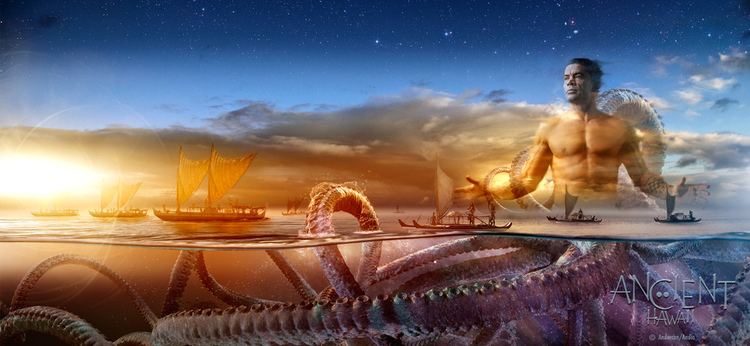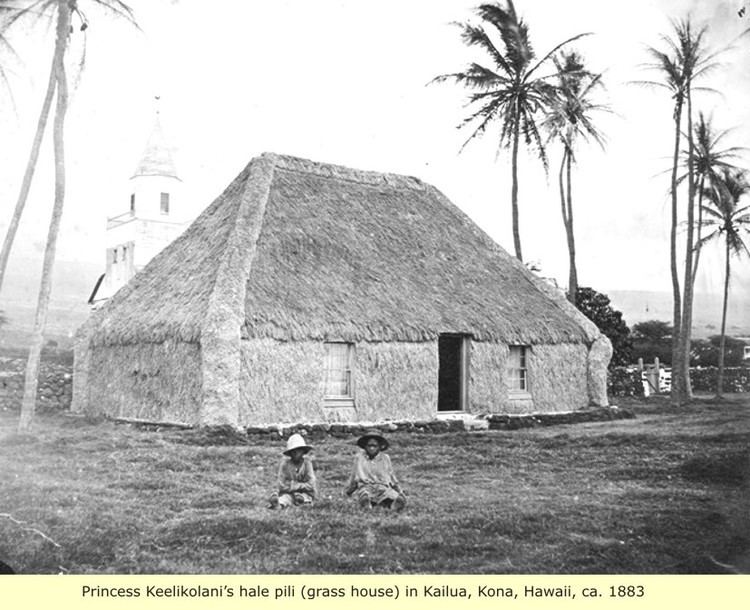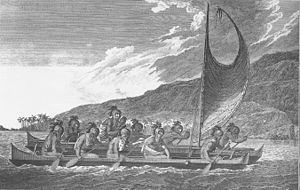 | ||
Ancient Hawaiʻi is the period of Hawaiian human history preceding the unification in 1810 of the Kingdom of Hawaiʻi by Kamehameha the Great. Researchers had based their estimates of first settlement by Polynesian long-distance navigators sometime between 300 and 800. In 2010, a study was published based on radiocarbon dating of more reliable samples and it suggests that the islands were settled much later, within a short timeframe, in c. 1219–1266.
Contents
- Voyage to the Hawaiian islands
- Settlement
- Village
- Caste system
- Education
- Land tenure
- Religion and the Kapu system
- Chiefs
- Subsistence economy
- First recorded European contact
- References

The islands in Eastern Polynesia have been characterized by the continuities among their cultures, and the short migration period would be an explanation of this result. Diversified agroforestry and aquaculture provided sustenance for Native Hawaiian cuisine. Tropical materials were adopted for housing. Elaborate temples (called heiau) were constructed from the lava rocks available.
The rich natural resources supported a relatively dense population, organized by a ruling class and social system with religious leaders. Captain James Cook made the first known European contact with ancient Hawaiians in 1778. He was followed by many other Europeans and Americans.

Voyage to the Hawaiian islands

There have been changing views about initial Polynesian discovery and settlement of Hawai'i. Radiocarbon Dating in Hawai'i initially indicated a possible settlement as early as 124. Patrick Vinton Kirch's books on Hawaiian archeology, standard textbooks, date the first Polynesian settlements to about 300 with more recent suggestions by Kirch as late as 600. Other theories suggest dating as late as 700 to 800.
In 2010 researchers announced new findings using revised, high-precision radiocarbon dating based on more reliable samples than were previously used in many dating studies. This new data indicates that the period of eastern and northern Polynesian colonization took place much later, in a shorter time frame of two waves: the "earliest in the Society Islands A.D. ∼1025–1120, four centuries later than previously assumed; then after 70–265 y, dispersal continued in one major pulse to all remaining islands A.D. ∼1190–1290." According to this research, settlement of the Hawaiian Islands took place ∼1219–1266CE. This rapid colonization is believed to account for the "remarkable uniformity of East Polynesia culture, biology and language."
Some writers believe that there were other settlers in Hawaiʻi, peoples who were forced back into remote valleys by newer arrivals. They claim that stories about menehune, little people who built heiau and fishponds, prove the existence of ancient peoples who settled the islands before the Hawaiians.
Settlement
The colonists brought along with them clothing, plants (called "canoe plants") and livestock and established settlements along the coasts and larger valleys. Upon their arrival, the settlers grew kalo (taro), maiʻa (banana), niu (coconut), ulu (breadfruit), and raised puaʻa (pork), moa (chicken), and ʻīlio (poi dog), although these meats were eaten less often than fruits, vegetables, and seafood. Popular condiments included pa'akai (salt), ground kukui nut, limu (seaweed), and ko (sugarcane) which was used as both a sweet and a medicine. In addition to the foods they brought, the settlers also acquired ʻuala (sweet potato), which has yet to be adequately explained, as the plant originates in South America. A few researchers have argued that the presence of the sweet potato in the ancient Hawaiian diet is evidence of pre-Columbian trans-oceanic contact with the Americas.
The Pacific rat accompanied humans on their journey to Hawaiʻi. David Burney argues that humans, along with the vertebrate animals they brought with them (pigs, dogs, chickens and rats), caused many native species of birds, plants and large land snails to become extinct in the process of colonization.
Estuaries and streams were adapted into fishponds by early Polynesian settlers. Packed earth and cut stone were used to create habitat, making Hawaiians some of the earliest, if not the first, aquaculturists. Over the course of the last millennium, Hawaiians undertook "large-scale canal-fed pond field irrigation" projects for kalo (taro) cultivation.
As soon as they arrived, the new settlers built hale (homes) and heiau (temples). Archaeologists currently believe that the first settlements were on the southern end of the Big Island of Hawaiʻi and that they quickly extended northwards, along the seacoasts and the easily accessible river valleys. As the population increased, settlements were made further inland. At this time, with the islands being so small, the population was very dense. Before European contact, the population had reached somewhere in the range of 200,000 to 1,000,000 people. After contact with the Europeans, however, the population steeply dropped due to various diseases including smallpox.
Village
A traditional town of ancient Hawaiʻi included several structures. Listed in order of importance:
Caste system
Ancient Hawaiʻi was a caste society developed from Polynesians. The main classes were:
Education
Hawaiian youth learned life skills and religion at home, often with grandparents. For "bright" children a system of apprenticeship existed in which very young students would begin learning a craft or profession by assisting an expert, or kahuna. As spiritual powers were perceived by Hawaiians to imbue all of nature, experts in many fields of work were known as kahuna, a term commonly understood to mean priest. The various types of kahuna passed on knowledge of their profession, be it in "genealogies, or mele, or herb medicine, or canoe building, or land boundaries," etc. by involving and instructing apprentices in their work. More formal schools existed for the study of hula, and likely for the study of higher levels of sacred knowledge.
The kahuna took the apprentice into his household as a member of the family, although often "the tutor was a relative". During a religious "graduation" ceremony, "the teacher consecrated the pupil, who thereafter was one with the teacher in psychic relationship as definite and obligatory as blood relationship." Like the children learning from their grandparents, children who were apprentices learned by watching and participating in daily life. Children were discouraged from asking questions in traditional Hawaiian culture.
Land tenure
In Hawaiian ideology, one does not "own" the land, but merely dwells on it. The belief was that both the land and the gods were immortal. This then informed the belief that land was also godly, and therefore above mortal and ungodly humans, and humans therefore could not own land. The Hawaiians thought that all land belonged to the gods (akua).
The aliʻi were believed to be "managers" of land. That is, they controlled those who worked on the land, the makaʻāinana.
On the death of one chief and the accession of another, lands were re-apportioned—some of the previous "managers" would lose their lands, and others would gain them. Lands were also re-apportioned when one chief defeated another and re-distributed the conquered lands as rewards to his warriors.
In practice, commoners had some security against capricious re-possession of their houses and farms. They were usually left in place, to pay tribute and supply labor to a new chief, under the supervision of a new konohiki, or overseer.
This system of land tenure is similar to the feudal system prevalent in Europe during the Middle Ages.
The ancient Hawaiians had the ahupuaʻa as their source of water management. Each ahupuaʻa had a sub-division of land from the mountain to the sea. The Hawaiians used the water from the rain that ran through the mountains as a form of irrigation. Hawaiians also settled around these parts of the land because of the farming that was done.
Religion and the Kapu system
Religion held ancient Hawaiian society together, affecting habits, lifestyles, work methods, social policy and law. The legal system was based on religious kapu, or taboos. There was a correct way to live, to worship, and even to eat. Examples of kapu included the provision that men and women could not eat together (ʻAikapu religion). Fishing was limited to specified seasons of the year. The shadow of the aliʻi must not be touched as it was stealing his mana.
The rigidity of the kapu system may have come from a second wave of migrations in 1000–1300 CE where different religions and systems were shared between Hawaiʻi and the Society Islands. Hawaiʻi would have been influenced by the Tahitian chiefs, the kapu system would have become stricter, and the social structure would have changed. Human sacrifice would have become a part of their new religious observance, and the aliʻi would have gained more power over the counsel of experts on the islands.
Kapu was derived from traditions and beliefs from Hawaiian worship of gods, demigods and ancestral mana. The forces of nature were personified as the main gods of Kū (God of War), Kāne (God of Light and Life), Kanaloa (God of Death), and Lono (God of peace and growth). Well-known lesser gods include Pele (Goddess of Fire) and her sister Hiʻiaka (Goddess of Dance). In a famous creation story, the demigod Māui fished the islands of Hawaiʻi from the sea after a little mistake he made on a fishing trip. From Haleakalā, Māui ensnared the sun in another story, forcing him to slow down so there was equal periods of darkness and light each day.
The Hawaiian mystical worldview allows for different gods and spirits to imbue any aspect of the natural world. From this mystical perspective, in addition to his presence in lightning and rainbows, the God of Light and Life, Kāne, can be present in rain and clouds and a peaceful breeze (typically the "home" of Lono).
Although all food and drink had religious significance to the ancient Hawaiians, special cultural emphasis was placed on ʻawa (kava) due to its narcotic properties. This root-based beverage, a psychoactive and a relaxant, was used to consecrate meals and commemorate ceremonies. It is often referred to in Hawaiian chant. Different varieties of the root were used by different castes, and the brew served as an "introduction to mysticism".
Chiefs
The four biggest islands, the island of Hawaiʻi, Maui, Kauaʻi and Oʻahu were generally ruled by their own aliʻi nui (supreme ruler) with lower ranking subordinate chiefs called aliʻi ʻaimoku, ruling individual districts with land agents called konohiki.
All these dynasties were interrelated and regarded all the Hawaiian people (and possibly all humans) as descendants of legendary parents, Wākea (symbolizing the air) and his wife Papa (symbolizing the earth). Up to the late eighteenth century, the island of Hawaiʻi had been ruled by one line descended from Umi-a-Liloa. At the death of Keaweʻīkekahialiʻiokamoku, a lower ranking chief, Alapainui, overthrew the two sons of the former ruler who were next in line as the island's aliʻi nui.
Assuming five to ten generations per century, the Aliʻi ʻAimoku dynasties were around three to six centuries old at 1800 CE. The Tahitian settlement of the Hawaiian islands is believed to have taken place in the thirteenth century. The aliʻi and other social castes were presumably established during this period.
Subsistence economy
The ancient Hawaiian economy became complex over time. People began to specialize in specific skills. Generations of families became committed to certain careers: roof thatchers, house builders, stone grinders, bird catchers who would make the feather cloaks of the aliʻi, canoe builders. Soon, entire islands began to specialize in certain skilled trades. Oʻahu became the chief kapa (tapa bark cloth) manufacturer. Maui became the chief canoe manufacturer. The island of Hawaiʻi exchanged bales of dried fish.
First recorded European contact
European contact with the Hawaiian islands marked the beginning of the end of the ancient Hawaiʻi period. In 1778, British Captain James Cook landed first on Kauaʻi, then sailed southwards to observe and explore the other islands in the chain.
When he first arrived at Kealakekua Bay in 1779, some of the natives believed Cook was their god Lono. Cook's mast and sails coincidentally resembled the emblem (a mast and sheet of white kapa) that symbolized Lono in their religious rituals; the ships arrived during the Makahiki season dedicated to Lono.
Captain Cook was eventually killed during a violent confrontation and left behind on the beach by his retreating sailors. The British demanded that his body be returned, but the Hawaiians had already performed funerary rituals of their tradition.
Within a few decades Kamehameha I used European warfare tactics and some firearms and cannon to unite the islands into the Kingdom of Hawaiʻi.
